Harley-Davidson LiveWire First Ride
The Motor Company makes motor history
Harley-Davidson’s electrically-powered LiveWire has sent shockwaves throughout the moto industry – and also through the general public. I don’t recall the last time Harley made a bigger splash in traditional media than the news of this electric motorcycle, which I got to ride yesterday on the streets of New York City.
The LiveWire impresses even before riding, as Harley engineers have clearly put a lot of effort into making this an e-bike that pleases the eyes. It borrows some elements from H-D’s dirt-track heritage, with a low, flat faux fuel tank and abbreviated tail section. Also low is the seat height, about 30 inches. A sand-cast, perimeter-style aluminum frame wraps around the batteries, while the electric motor is proudly on display at the bottom end of the bike. Harley designers describe the longitudinally mounted motor with its billet aluminum housing as a highlight of the LiveWire.
Positioning the motor longitudinally forces a complicated arrangement for driving the rear wheel. The motor’s output shaft uses a spiral-bevel drive to change the rotation to a sideways orientation. From there, a small belt transfers power to a sprocket located concentrically with the swingarm pivot (which negates the need for belt-tension adjustment), then finally to the rear wheel via a traditional belt drive.
Discuss this at our Harley-Davidson LiveWire Forum.
The heat generated by the various systems is managed in different ways. The gearbox and motor are cooled by oil, while the batteries are cooled by air. Heat from the electronic motor controller is shed by liquid circulated through a small radiator.
The LiveWire’s only carryover parts are the Nissin brakes, LED signals, mirrors, hand controls and a tail lamp, the latter borrowed from a V-Rod and inverted in this application.
MORE: Harley-Davidson Reveals Project Livewire
An electronic key fob activates the LiveWire, while traditional Harley switchgear is used to ready the system for launch. A full-color TFT screen displays a multitude of information, including battery charge, range and temperatures for the motor controller, motor and battery pack. A rider has the choice of two thrust delivery modes: Range or Power. Naturally, I chose Power.
Harley says its motor produces 75 hp and 52 ft-lb. of torque at its peaks, which enables a sprint to 60 mph in less than four seconds. Acceleration is indeed brisk, leaping away from traffic with a quiet ferocity that thrills even motojournos jaded by big power. It’s likely the LiveWire could go wheel to wheel with Zero’s speedy new SR. Top speed is limited to 95 mph, which is a velocity we didn’t come near while on the congested streets of Manhattan.
Perhaps the most difficult aspect of tuning an electric motorbike is programming its motor controller to transform ones and zeros into natural feeling throttle response. Here, the LiveWire shines. It can pull away from a stop as gently as an expertly calibrated clutch hand. Also earning praise is the tuning of its regenerative braking, which applies force to the electric motor when rolling off the throttle in a manner that deftly imitates engine braking from an internal combustion powerplant.
The LiveWire’s ergonomics are pleasant, with a modest reach to the handlebars and a reasonable amount of legroom. Its seating position suited my shortish body, but I could imagine taller riders would feel short on fore/aft space. In contrast to Brammo’s Empulse, the LiveWire is incredibly slim between a rider’s knees. Its mirrors, mounted below the handlebar, look nicer than they work.
Handling performance seemed to be quite good, but firm opinions will require more than just a few miles on the streets of NYC. Still, the fully adjustable Showa suspension seemed to work well, and the chassis responded fairly quickly to shoves on the handlebars. Harley was reluctant to release the weight of the LiveWire, but we suspect it scales in at less than 480 pounds, thanks in part to its cast-aluminum frame purported to weigh just 14 pounds. The LiveWire’s cast-aluminum wheels are said to be the lightest hoops ever mounted to a Harley.
Obviously, there’s the question of range, which is impossible for us to verify based on our very short ride and the fact that Harley hasn’t released the LiveWire’s battery specs. A 53-mile range in mixed riding was hinted at, leading us to believe a battery capacity of about 10 kilowatt/hour.
Jeff Richlen, the LiveWire’s lead engineer, told us that a range of at least 100 miles is needed before an e-bike starts to make sense for most riders.
And that’s the reason why the LiveWire is thus far a proof of concept machine rather than a production bike. Harley is spending the next year or two evaluating customer feedback via its “Project LiveWire Experience,” a cross-country tour of two trucks, each with 11 LiveWires, headed to Harley dealerships in 30 U.S. cities. Reservations can be booked online at ProjectLiveWire.com. The demos will continue in Canada and Europe in 2015.
Based on the tour dates, we think the emergence of a production version of the LiveWire is at least 18 months away, perhaps as long as two years or more while the energy density of batteries improves.
However, you can be sure a LiveWire will arrive at Harley dealerships at some point in the future. The immense buzz from the bike’s debut is way too strong to ignore.
More by Kevin Duke



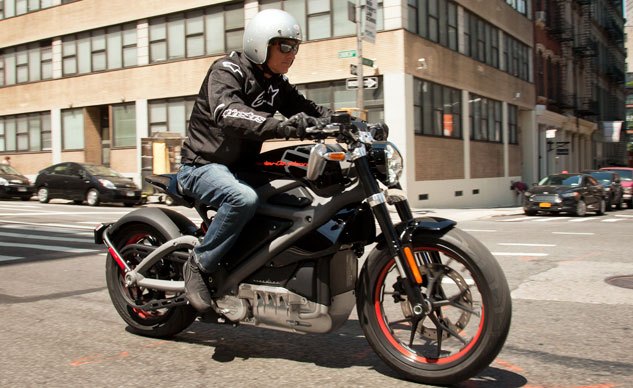
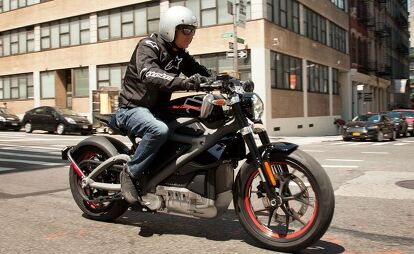
























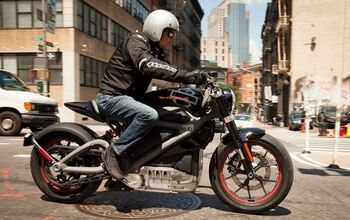


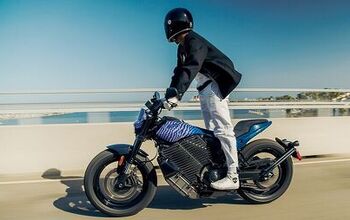
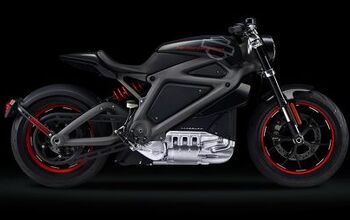












Comments
Join the conversation
Below is a proposed 30 second TV commercial for Harley's Wildfire electric bike. This version
is aimed at new expanding group of potential buyers... young, environmentally aware,
urban, and looking for a thrill.
The Darth Vader voice underscores the threat…. a wrong decision will imperil the
future of our planet and the human race.
Let's give HD some help here! Please REPLY with your own version
… Just re-write the version below.
Charles O. Slavens
SCENE 1:
VIDEO - FI - A dark mountain ridge silhouetted against the upper limb of a rising moon – CUT
SFX – high pitched whine of a jet engine winding up
NARR – Darth Vader voice: “The future is in your hands.”
SCENE 2:
VIDEO – CU a single headlight flares…a pump zoom back to a long shot of a rider outlined against the full moon. The moonlight is reflected in the centerline of the highway. --- CUT
SFX -- whine approaches and shrieks past, changing tone dramatically via the doppler effect.
NARR – Darth Vader voice: “The key to survival on your planet lies with you.”
SCENE 3:
VIDEO – low angle medium shot of the bike at speed from the front as the headlight flares. The camera moves to the side and the bike drift by, revealing details. --- CUT
VIDEO -- Close up of the Harley Davidson logo. --- CUT
SFX – jet engine whine continues
NARR – New voice (Alan Sklar)…. “Rising to lead is a quintessential icon of American ingenuity – Harley Davidson… long a symbol of ability and American resourcefulness.”
SCENE 4:
VIDEO – The biker is now in the Holland Tunnel whizzing past large trucks.
--- CUT
SFX – The ever-present whine of the jet engine is loud, echoing off the tiled
walls.
NARR – “It’s coming… the beginning of something new”
SCENE 5:
VIDEO – Dawn is breaking in Downtown NYC. We’re in the financial district. Our rider dismounts, takes off her helmet and shakes out her hair. In the background we see the façade of the NYSE. --- CUT
NARR – We see the path… it’s going to happen.
SCENE 6:
VIDEO – Our rider walks past a low angle look at Wall Street's charging bull in the foreground. --- DISSOLVE
NARR – Harley Davidson is moving forward with what is great about America.
SCENE 7:
VIDEO – HD/Livewire logo --- FO
SFX – music up and out.
I'm an RC (radio controlled) airplane pilot and more of us have gone over to electron propulsion than burning hydrocarbon fuel over the past few years. The technology has made tremendous strides just in the last couple years. Our nitro fuel is about $9/qt, give or take a little and there is a lot less clean-up after a flight. There are still some of the older guys who won't give up internal combustion but the writing is on the walls and the components, motors, batteries, and ESC's are getting cheaper by the minute. When I first heard that H.D. was looking at an electric bike I figured, if Harley is willing to spend the money then there must be more to the story. As far as range goes, personally I'd like at least 200 miles but I know that a lot of people who want to have a 200 mile range rarely actually go much more than 100 miles for an average ride and in fact most of my riding buddies could live with 50 because they don't have the time to do much more than that. Fifty miles would do for a lot of people who just want one for commuting. I'd put my money on seeing an electric Harley within a couple years.